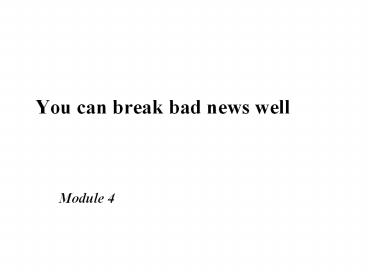Module 4 - PowerPoint PPT Presentation
1 / 14
Title:
Module 4
Description:
Title: No Slide Title Author: Dr Mhoira Leng Last modified by: mhoira Created Date: 2/8/1999 8:25:50 PM Document presentation format: On-screen Show (4:3) – PowerPoint PPT presentation
Number of Views:19
Avg rating:3.0/5.0
Title: Module 4
1
You can break bad news well
- Module 4
2
Learning objectives
- Discuss the value of telling the truth to
patients - Demonstrate the steps in Break News
3
Case Scenario
- You are seeing a 54 year old man at home who has
come from the hospital where he has had some
tests done. The medical note says that the test
shows advanced cancer of the oesophagus - Should you tell him the truth?
- Why or why not?
4
Telling the truth
- Benefits
- reduces uncertainty and helps to answer
unanswered questions reduces unrealistic hope - allows the patient to make informed choices and
reduce expenditure on futile treatments - allows the patient to make realistic plans
- allows honest communication with family and
health workers - if done well, can build on the relationship of
trust between patient and carer.
5
Telling the truth
- Truth is one of the most powerful medicines
available to us, but we still need to develop a
proper understanding of the right timing and - dosage for each patient.
- Adapted from Simpson (1979)
6
Case scenario contd
- While you are thinking what to tell him, his
daughter asks to speak to you outside. She says
You must not tell him anything that may upset
him. He will not cope. - Should you agree to the daughters request?
- Why or why not?
7
Handling collusion
- Acknowledge reaction and the relatives concern
- Explore the reasons and acknowledge them
- Avoid judgmental response
- Ask how does it affect him / her
- Explain likely problems for the patient and
family - Try to work out a mutually acceptable solution
8
Breaking bad news
- Who does it?
- those who the patient knows and trusts
- those who have the skill of conveying the message
- those who can handle the reactions effectively
- those who know the disease, prognosis and the
treatment
9
Breaking bad news
- When?
- whenever the patient asks
- provided the patient has been given the
opportunity to ask! - breaking bad news can be an ongoing process
10
Steps to breaking bad news
- Set the right physical context
- Explore the level of awareness
- Explore what patient wants to know
- Sharing the information
- warning shot
- pause
- brief Information
- check clarity
- Handling reactions
- Future Plan
11
Steps using BREAK NEWS
- Be prepared
- Relatives think who should be there
- Expectations check
- Assess what is appropriate
- Knowledge sharing
- Never say there is nothing we can do
- Empathise
- Way forward including review and repetition
- Stop and reflect
12
Role Play
- A 60 year old woman in a general medical ward who
has cancer of her breast. Her swelling is
discharging pus. She is very weak and her husband
tells you that she is not eating the hospital
food. She complains of pain in her back and has a
large wound on her sacrum. - She asks
- Why is the wound not healing?
- What is happening to me?
13
Summary
- Best learned through experience
- Identify our skills and try to refine them
- Identify our shortcomings and try to overcome
them - There are no fixed guidelines
- Should be patient centered and context oriented
14
- These resources are developed as part of the THET
multi-country project whose goal is to strengthen
and integrate palliative care into national
health systems through a public health primary
care approach - Acknowledgement given to Cairdeas International
Palliative Care Trust and MPCU for their
preparation and adaptation - part of the teaching materials for the Palliative
Care Toolkit training with modules as per the
Training Manual - can be used as basic PC presentations when
facilitators are encouraged to adapt and make
contextual































